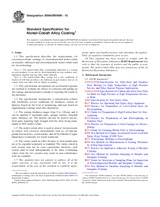We need your consent to use the individual data so that you can see information about your interests, among other things. Click "OK" to give your consent.
ASTM B994/B994M-15
Standard Specification for Nickel-Cobalt Alloy Coating
STANDARD published on 1.3.2015
The information about the standard:
Designation standards: ASTM B994/B994M-15
Note: WITHDRAWN
Publication date standards: 1.3.2015
SKU: NS-583327
The number of pages: 8
Approximate weight : 24 g (0.05 lbs)
Country: American technical standard
Category: Technical standards ASTM
The category - similar standards:
Annotation of standard text ASTM B994/B994M-15 :
Keywords:
alloy, coating, cobalt, corrosion, corrosion in threaded articles, corrosion rate, dismantle, electrochemical testing, metal coating, nickel, nickel-cobalt alloy, performance, protective coating, salt spray (fog) chamber, torque ratio,, ICS Number Code 25.220.40 (Metallic coatings)
Additional information
| 1. Scope | ||||||||||||||||||||||||||||||||||||||||||||||||||||||
|
1.1 This specification describes the requirements for corrosion-resistant coatings of electrodeposited nickel-cobalt on metallic substrates and electrodeposited nickel-cobalt used for electroforming. Note 1: The nickel-cobalt alloy is principally deposited as a
coating on steel products. It can also be electrodeposited on iron,
stainless steel, aluminum, titanium and any other metal
substrate.
Note 2: The nickel-cobalt alloy coating has a low coefficient
of friction of 0.08 that provides a dry lubricant on part surfaces
that are in contact with each other and are subject to
galling.
1.2 This specification incorporates an accelerated exposure test method to evaluate the effects of corrosion and galling on the coating, and incorporates a means of reporting the results to the purchaser. 1.3 The specification incorporates a classification scheme that establishes service conditions for thickness, classes of deposits based on the level of monitoring, and type based on supplemental coatings used after deposition. 1.4 The coating thickness ranges from 5 to >30 μm, and it can be applied to machined parts, springs, latches, threaded parts, fasteners, etc. The deposit can also be used to electroform parts requiring high strength with the alloy being maintained at 50% nickel-cobalt. 1.5 The nickel-cobalt alloy is used to protect ferrous metals in contact with corrosive environments such as: oil and gas production facilities, costal marine, and ACQ (Alkaline Copper Quaternary) treatments for wood treatments. 1.6 The values stated in either SI units or inch-pound units are to be regarded separately as standard. The values stated in each system may not be exact equivalents; therefore, each system shall be used independently of the other. Combining values from the two systems may result in non-conformance with the standard. 1.7 This standard does not purport to address all of the safety concerns, if any, associated with its use. It is the responsibility of the user of this standard to establish appropriate safety and health practices and determine the applicability of regulatory limitations prior to use. 1.8 This standard has been revised to comply with
the Restriction of Hazardous Substances
Standard Guide for Selection of Sampling
Plans for Inspection of Electrodeposited Metallic and Inorganic
Coatings Standard Guide of Variables Sampling of
Metallic and Inorganic Coatings Standard Specification for Pre-Treatments
of Iron or Steel for Reducing Risk of Hydrogen Embrittlement Standard Guide for Post-Coating
Treatments of Steel for Reducing the Risk of Hydrogen
Embrittlement Standard Specification for Reagent
Water Standard Test Method for Analysis of
Ni-Base Alloys by Wavelength Dispersive X-Ray Fluorescence
Spectrometry Standard Practice for Preparation of and
Electroplating on Stainless Steel (Includes all amendments and
changes 12/7/2020). Standard Specification for Carbon Steel,
Alloy Steel, and Stainless Steel Nuts for Bolts for High Pressure
or High Temperature Service, or Both Standard Specification for Tool Steels
Alloy Standard Practice for Operating Salt
Spray (Fog) Apparatus Standard Practice for Preparation of
Low-Carbon Steel for Electroplating Standard Guide for Preparation of
High-Carbon Steel for Electroplating Standard Specification for Alloy-Steel
and Stainless Steel Bolting for High Temperature or High Pressure
Service and Other Special Purpose Applications Standard Guide for Cleaning Metals Prior
to Electroplating (Includes all amendments and changes
12/7/2020). Standard Test Method for
Copper-Accelerated Acetic Acid-Salt Spray (Fog) Testing (CASS
Test) Standard Terminology Relating to
Electroplating Standard Test Method for Measurement of
Coating Thickness by X-Ray Spectrometry Standard Practice for Preparation of Iron
Castings for Electroplating Standard Practice for Qualitative
Adhesion Testing of Metallic Coatings Standard Test Method for Mechanical
Hydrogen Embrittlement Evaluation of Plating/Coating Processes and
Service Environments Standard Practice for Fastener Sampling
for Specified Mechanical Properties and Performance Inspection Standard Test Method for Conducting
Potentiodynamic Polarization Resistance Measurements Standard Practice for Modified Salt Spray
(Fog) Testing Standard Practice for Calculation of
Corrosion Rates and Related Information from Electrochemical
Measurements Standard Terminology and Acronyms
Relating to Corrosion ISO/IEC 17025:2005 General Requirements for the Competence
of Testing and Calibration Laboratories Standard Guide for Attribute Sampling of
Metallic and Inorganic Coatings |
We recommend:
Updating of laws
Do you want to be sure about the validity of used regulations?
We offer you a solution so that you could use valid and updated legislative regulations.
Would you like to get more information? Look at this page.




 Cookies
Cookies
